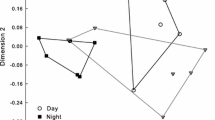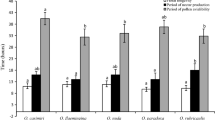Summary
The effects of time of the day and frequency of application and of purity of artificially deposited pollen loads on fruiting and seed set were studied in Rhinanthus angustifolius (diurnally visited by bumblebees) and Viscaria vulgaris (diurnally visited by bumblebees, nocturnally by sphingid moths).
Time of the day did not influence pollination success in either species. Increase of pollination frequency increased fruiting and seed set in Rhinanthus but had no affect on Viscaria. Five successive artificial pollinations were needed to achieve seed set equal to that observed naturally in Rhinanthus while a single artificial pollination was sufficient in Viscaria. Mixing Lupinus and Viscaria pollen did not reduce fruiting and seed set in Viscaria. The results are discussed in relation to observed seed sets in early and late flowers, and small and large patches of Viscaria vulgaris and among Rhinanthus flowers in populations of different densities.
Similar content being viewed by others
References
Augspurger CK (1980) Mass-flowering of a tropical shrub (Hybanthus prunifolius): Influence on pollinator attraction and movement. Evolution (Lawrence, Kansas) 34:475–488
Bertin RI, Willson MF (1980) Effectiveness of diurnal and nocturnal pollination of two milkweeds. Can J Bot 58:1744–1746
Bierzychudek P (1981) Pollinator limitation of plant reproductive effort. Am Nat 117:838–840
Borg SJ ter (1985) Population biology and habitat relation of some hemiparasitic Scrophulariaceae. In: White J (ed) The population structure of vegatation. Pages 463–487. Dr W Junk Publishers, Dordrecht
Chang WM, Struckmeyer BE (1976) Influence of temperature, time of day and flower age on pollen germination, stigma receptivity, pollen tube growth and fruit set of Allium cepa L. J Am Soc Hortic Sci 101:81–83
Grant V (1963) The origin of adaptations. Columbia University Press, New York London
Hammer K (1975) Zur Blutenökologie der Roten Lichtnelke, Silene dioica (L.) Clair. (Melandrium rubrum (Weigel) Garcke). Hercynia (Leipzig). 2:213–216
Heinrich B (1979) “Majoring” and “minoring” by foraging bumblebees, Bombus vagans: An experimental analysis. Ecology 60:245–255
Jennersten O (1985) Pollination and fungal disease transmission: Interactions between Viscaria vulgaris, Ustilago and insects. Acta Univ Ups 793:1–30
Kwak MM (1977) Pollination ecology of 5 hemiparasitic, largeflowered Rhinanthoideae with special reference to the pollination behaviour of nectar-thieving, short-tongued bumblebees. Acta Bot Neerl 26:97–107
Kwak MM (1979) Maintenance of species integrity in sympatrically occurring Rhinanthus minor and R. serotinus in the Netherlands. Oecologia (Berlin) 41:1–9
Kwak MM (1980) Artificial and natural hybridization and introgression in Rhinanthus (Scrophulariaceae) in relation to bumblebee pollination. Taxon 29:613–628
Mann LP, Woodbury GW (1969) The effect of age, time of day and variety on pollen germination of onion, Allium cepa L. J Am Soc Hortic Sci 94:102–104
Morse DH, Fritz RS (1983) Contributions of diurnal and nocturnal insects to the pollination of common milkweed (Asclepias syriaca L.) in a pollen-limited system. Oecologia (Berlin) 60:190–197
Motten AF (1983) Reproduction of Erythronium umbilicatum (Liliaceae): Pollination success and pollinator effectiviness. Oecologia (Berlin) 59:351–359
Mulcahy DL (1967) Optimal sex ratio in Silene alba. Heredity 22:411–423
Nye WP, Waller GD, Water ND (1971) Factors affecting pollination of onion in Idaho during 1969. J Am Soc Hortic Sci 96:330–332
Proctor M, Yeo P (1975) The pollination of flowers. Collin, London
Rathcke B (1983) Competition and facilitation among plants for pollination. In: Real L (ed) Pollination biology. Pages 277–293. Academic Press, Orlando Florida
Schemske DE, Willson MF, Melampy MN, Miller LJ, Verner L, Schemske KM, Best LB (1978) Flowering ecology of some spring woodland herbs. Ecology 59:351–366
Silander JA, Primack RB (1976) Pollination intensity and seed set in the evening primrose (Oenothera fruticosa). Am Midl Nat 100:213–216
Stephenson AG (1979) An evolutionary examination of the floral display of Catalpa speciosa (Bignoniaceae). Evolution (Lawrence, Kansas) 33:1200–1209
Sukhada DK, Jayachandra (1980) Pollen allelopathy—a new phenomenon. New Phytol 84:739–746
Thomas JB, Anderson RG (1978) Cross-incompatibility of common wheat with rye: effect of varying the day of pollination on seed set and development. Can J Bot 56:3000–3007
Thomson JD, Andrews BJ, Plowright RC (1981) The effect of a foreign pollen on ovule development in Diervilla lonicera (Caprifoliaceae). New Phytol 90:777–783
Visser T, Verhaegh JJ (1980) Pollen and pollination experiments: II The influence of the first pollination on the effectiveness of the second one in apple. Euphitica 29:385–390
Waser NM (1978) Competition for hummingbird pollination and sequential flowering in two colorado wild flowers. Ecology 59:934–944
Waser NM (1983) Competition for pollination and floral character differences among sympatric plant species: A review of evidence. In: John CE, Little RJ (eds) Handbook of experimental pollination biology. Pages 277–293. Van Nostrand Reinhold, New York
Weller SG (1979) Variation in heterostylous reproductive systems among populations of Oxalis alpina in S.E. Arizona. Syst Bot 4:57–71
Willson MF, Burley N (1983) Mate choice in plants: Tactics, mechanisms, and consequences. Princeton University Press, Princeton New Jersey
Willson MF, Miller LJ, Rathcke BJ (1979) Floral display in Phlox and Geranium: Adaptive aspects. Evolution (Lawrence, Kansas) 33:52–63
Zimmerman M (1980) Reproduction in Polemonium: Competition for pollinators. Ecology 61:497–501
Author information
Authors and Affiliations
Rights and permissions
About this article
Cite this article
Kwak, M.M., Jennersten, O. The significance of pollination time and frequency and of purity of pollen loads for seed set in Rhinanthus angustifolius (Scrophulariaceae) and Viscaria vulgaris (Caryophyllaceae). Oecologia 70, 502–507 (1986). https://doi.org/10.1007/BF00379895
Received:
Issue Date:
DOI: https://doi.org/10.1007/BF00379895




